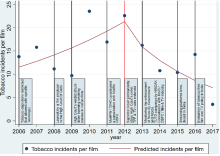In 2012, after a 7-year battle starting in 2005, India implemented rules to reduce the pro-tobacco impact of onscreen smoking in movies and on TV. The new rules required that any film or TV program that included tobacco use include
- Anti-tobacco ads before and at the intermission
- An onscreen anti-tobacco message during any tobacco use in the film or program

Working with colleagues in India and at the World Health Organization, we recently published “Changes in tobacco depictions after implementation of tobacco-free film and TV rules in Bollywood films in India: a trend analysis” that assessed the impact of the rules on the amount of onscreen smoking. While there is still room for improvement in compliance with the rules, there was a dramatic reversal in the increasing amount of onscreen smoking in movies after the rules took effect. Specifically, before implementation of the rules, the number of tobacco incidents per film was increasing by a factor of 1.1/year (95% CI 1.0 to 1.2, p=0.002). This situation reversed beginning in 2013, when the number of incidents per film started falling significantly by a factor of 0.7/year (95% CI 0.6 to 0.9; p=0.012) compared with the previous increasing trend. The percentage of youth-rated (U and UA) films with any tobacco incidents also declined from a peak of 76% in 2012 to 35% in 2017.
This result provides important information as the WHO Framework Convention on Tobacco Control Conference of Parties considers how to supplement Article 13 guidelines on the prevent use of entertainment media to promote tobacco use. Specifically, it shows that sensible government regulation can make a different in onscreen smoking (which causes youth to smoke).
My colleagues in India put a press release out on the paper:
India’s Tobacco Free Films and TV Rules (2012) effectively reduced tobacco depictions in Bollywood films
Enhanced monitoring of compliance and ensuring that the same rules apply to streaming video platforms are needed to ensure the continued effectiveness of the rules
The Tobacco-Free Film and TV Rules (2012) in India were followed by a reduction in the depiction of tobacco incidents in Bollywood films over the years, reveals a study examining tobacco incidents in top-grossing Bollywood films between the years 2006 and 2017, recently published online in the Tobacco Control journal.
The researchers studied the tobacco imagery trends in 240 top-grossing Bollywood films screened between 2006 and 2017; and compliance with the rules in these films, 2012 onwards. The researchers used a validated method (Breathe California) to count the tobacco incidents in the films.
According to Dr. Gaurang P. Nazar, the corresponding author of this study, “the number of tobacco incidents per film was increasing by about 10% per year (incidence rate ratio of 1.1 per year) before the rules took effect in October 2012. However, post-implementation of the rules, the number of tobacco incidents per film began to decline significantly by about 30% per year (IRR 0.7 per year).
After 2012, there was moderate compliance with the rules that required a static warning on the screen every time tobacco use was displayed, audio-visual disclaimers and use of anti-tobacco health spots before and at intermission of films with tobacco. Although the level of brand placement was low, some films continued to display tobacco brands even after the rules went into effect.”
Section 5 of India’s Cigarettes and Other Tobacco Products Act (COTPA 2003) prohibits
advertising and promotion of tobacco products in any media and this prohibition extends
to the depiction of tobacco products or their use in films & TV programs. The prohibition is particularly aimed at protecting children and adolescents from exposure to tobacco imagery in films and TV programs. Previous research from India as well as globally has shown that such exposure causes tobacco use in this vulnerable population.
Dr. Monika Arora, one of the senior authors of this study says, “We observed that the percentage of films depicting tobacco incidents in youth-rated (U and U/A rated) films was 76% in 2012. However, since the enforcement of the rules in 2012, this percentage has been reducing (35% in 2017). This also indicates that rules have been effective in restricting – but not eliminating – the depiction of tobacco imagery in youth-rated films.
Enhanced monitoring and implementation of the rules by the Central Board of Film Certification of the Ministry of Information and Broadcasting (MoIB) as well as the Ministry of Health & Family Welfare (MoHFW), Government of India is necessary to finish the job and ensure there are no violations of the prescribed rules. The production houses and filmmakers should also be sensitized about the issue and exercise accountability towards the youth of India.”
The reduction in tobacco incidents in top-grossing films was potentially helped by the effective monitoring of the rules by MoHFW, the World Health Organization and the civil society. Additionally, the evaluation of tobacco-free film and television rules in India by WHO and Vital Strategies reporting the instances of tobacco imagery in top-grossing movies and TV programs in the year 2016 may have also helped to maintain lower rates of tobacco incidents in top-grossing films in 2017.
“India has been a leader in protecting its youth from the tobacco industry’s historic use of film and TV to promote tobacco use. The Indian experience provides a model for other countries to enact laws and regulations to implement Article 13 of the WHO Framework Convention on Tobacco Control to prevent the use of media to promote tobacco use” according to Stanton Glantz, a retired Professor of Medicine from the University of California San Francisco who is a coauthor of the study.
A major problem for protecting Indian youth from onscreen tobacco promotions has been the advent of streaming video platforms such as Netflix, Amazon Prime, Hotstar etc. among others. Although Section 5 of COTPA, which mandates a complete ban on tobacco advertising and promotion in any form of media, these online streaming platforms do not comply with the tobacco-free film and TV rules. A previous study conducted by this group of researchers, also supported by the WHO and published in the Tobacco Control journal has shown that the depiction of tobacco imagery is several-fold higher in streaming platforms which continue to flout the tobacco-free film and TV rules.
“The Tobacco Free film policy pioneered by the Government of India is aligned with the guidelines under Article 13 of the WHO FCTC that provide us with a blueprint to regulate the depiction of tobacco products or their use in films and TV. The gains made in the area need to be sustained through regular monitoring of its enforcement,” said Dr Roderico H. Ofrin, WHO Country Representative to India.
While implementation of the Tobacco-free film and TV rules was followed by a reversal of the increasing trend in tobacco incidents among top-grossing Bollywood films between 2006 to 2017, compliance with the rules is still incomplete and requires consistent and joint efforts from MoIB, MoHFW and other stakeholders. In particular, the Central Board of Film Certification needs to implement the rule requiring specific documented ‘strong editorial justification’ for any tobacco use into its formal certification process.
Title of the study: Changes in tobacco depictions after implementation of tobacco-free film and TV rules in Bollywood films in India: A trend analysis.
Journal: Tobacco Control
Available (doi): 10.1136/tobaccocontrol-2021-056629
Publication date (Online): 27th July 2021
Here is the abstract:
Background: India’s tobacco-free film and TV rules were implemented from 2012. To assess the effect of the rules, we studied tobacco depictions in top-grossing Bollywood films released between 2006 and 2017 and rule compliance after 2012.
Methods: Tobacco incidents and brand appearances were coded in 240 top-grossing Bollywood films (2006-2017) using the Breathe California method. Trends in number of tobacco incidents per film per year were studied before and after implementation of the rules using Poisson regression analysis. Compliance with rules over the years was studied using Pearson product-moment correlations.
Results: Forty-five films were U-rated (all ages), 162 were UA-rated (below age 12 years must be adult-accompanied), and 33 were A-rated (age 18+ years only). Before implementation of the rules, the number of tobacco incidents per film was increasing by a factor of 1.1/year (95% CI 1.0 to 1.2, p=0.002). However, beginning year 2013, the number of incidents per film started falling significantly by a factor of 0.7/year (95% CI 0.6 to 0.9; p=0.012) compared with the previous increasing trend. The percentage of youth-rated (U and UA) films with any tobacco incidents also declined from a peak of 76% in 2012 to 35% in 2017. The percentage of films complying with the rules (audio-visual disclaimers, health spots, static warnings) did not change significantly from 2012 to 2017.
Conclusion: India’s 2012 rules were followed by a reduction in tobacco depictions in Bollywood films. Enhanced monitoring of compliance is needed to ensure the continued effectiveness of the rules.
The full citation is: Nazar GP, Arora M, Sharma N, Shrivastava S, Rawal T, Chugh A, Sinha P, Munish VG, Tullu FT, Schotte K, Polansky JR, Glantz S. Changes in tobacco depictions after implementation of tobacco-free film and TV rules in Bollywood films in India: a trend analysis. Tob Control. 2021 Jul 26:tobaccocontrol-2021-056629. doi: 10.1136/tobaccocontrol-2021-056629. Epub ahead of print. PMID: 34312318. It is available here.
